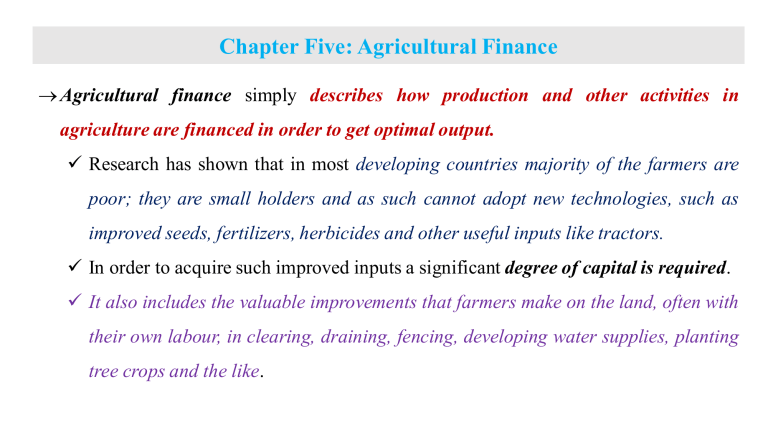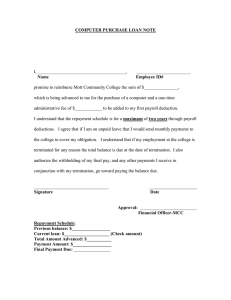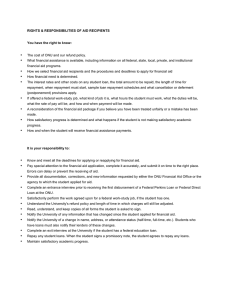
Chapter Five: Agricultural Finance Agricultural finance simply describes how production and other activities in agriculture are financed in order to get optimal output. Research has shown that in most developing countries majority of the farmers are poor; they are small holders and as such cannot adopt new technologies, such as improved seeds, fertilizers, herbicides and other useful inputs like tractors. In order to acquire such improved inputs a significant degree of capital is required. It also includes the valuable improvements that farmers make on the land, often with their own labour, in clearing, draining, fencing, developing water supplies, planting tree crops and the like. In addition to capital employed directly on the farm, agriculture also requires a vast amount of capital for the farm supplies, processing and marketing Therefore, agricultural finance is an economic study of financing agricultural activities with the aim of increasing farm profit Farm finance includes the principles of farm credits, the ways in which farmers make use of credit and the activities of lending agencies. Credit as an exchange of goods and services on the basis of promise for future payment. The roles of credit; Credit is the key means to have access to inputs in any development program. Credit can be used as an instrument for market stability. Credit plays a key role in covering consumption deficit. Sources of Agricultural Finance Sources of finance for agricultural projects are quite many and in this context refer to the lenders, ranging from the relatives of the borrowers to government. The various sources are derived from two major sources, namely, Institutional/formal sources and non-institutional/ informal sources. Importance of Agricultural Finance The agricultural finance is required for the following reasons: The scope for extensive agriculture in developing countries is limited. Therefore, increase in agricultural production is possible only by intensification and diversification of farming. Intensive agriculture needs huge capital. The purchasing power of small and marginal farmers is limited to their subsistence farming. Hence, they have to depend on the external financial assistance to use the costlier (modern) inputs. Farmers economic condition is subject to frequent onslaught of flood, drought, famine etc. Therefore, either the continuance of cultivation of crops or making improvements on the farms depends on the nature and availability of finance. In recent years, more area is brought under irrigation which in turn would increase the use of inputs like fertilizer and plant protection chemicals. In order to accomplish this, external finance is needed. In order to sustain the development of agro-based industries, there should be a substantial increase in the supply of raw materials needed for such industries. Therefore, for the development of farm sector, a constant flow of credit is essential and it would enhance over all growth of the economy. In agriculture, fixed capital is locked up in permanent investments like land, buildings, etc. Moreover, it takes a long time to get returns from farm. Hence, farmers need finance to continue their farm operations. The weaker sections of the farming community should be motivated to participate in development programmes by giving financial assistance to acquire productive assets. Small and marginal farmer’s are trapped in the vicious cycle of poverty i.e., low returns → low saving → low investment → low return. To break this cycle, credit has to be injected in agricultural sector. Credit Worthiness Analysis Credit worthiness analysis involves the investigation of the environment surrounding the loan and its impact on repayment. Creditworthiness is how a lender determines that you will default on your debt obligations, or how worthy you are to receive new credit. Assessment of credit worthiness helps the lender to know the factors that may reduce the likelihood of the repayment of its capital on priori and act proactively. oCreditworthiness is based on a number of things, often referred to as the six “C’s” of credit. The intent of this analysis is to determine: 1. Will the borrower pay? (Character or credit reputation); 2. Can the borrower pay? (Capacity); 3. Does the borrower have enough cash on hand to pay if a period of adversity arises? (Capital); 4. Will something adversely affect the borrower’s ability to pay? (Conditions); 5. Will the credit issuer be protected if the borrower fails to repay the loan? (Collateral); and 6. Does the borrower demonstrate an ability to make wise decisions? (Commonsense). Loan repayment Plans Based on time: the repayment period of the loan is sub-divided in to 3 types Short–term loans: These loans are to be repaid within a period of 6 to 18 months. All crop loans are said to be short–term loans, but the length of the repayment period varies according to the duration of crop. The farmers require this type of credit to meet the expenses of the ongoing agricultural operations on the farm like sowing, fertilizer application, plant protection measures, payment of wages to casual labourers etc. The borrower is supposed to repay the loan from the sale proceeds of the crops raised. Medium – term loans: the repayment period varies from 18 months to 5 years. These loans are required by the farmers for bringing about some improvements on his farm by way of purchasing implements, electric motors, milch cattle, sheep and goat, etc. Long – term loans: these loans fall due for repayment over a long time ranging from 5 years to more than 20 years or even more. These loans together with medium terms loans are called investment loans or term loans. These loans are meant for permanent improvements like levelling and reclamation of land, construction of farm buildings, purchase of tractors, raising of orchards, etc. Since these activities require large capital, a longer period is required to repay these loans due to their non - liquidating nature. Common types of repayment plans for term loans include: Straight-end Repayment Plan or Single Repayment Plan The entire loan amount is to be cleared off after the expiry of stipulated time period. Partial repayment plan or Balloon repayment plan Balloon payment loans are relatively shorter-term loans (e.g., five years). Here, the repayment of the loan will be done partially over the years. At the end of the period, the entire unpaid balance of the loan is due; the principal must either be paid in full or new loan terms must be negotiated. This is called “balloon repayment plan” as the large final payment made at the end of the loan period (i.e. in the final year) after a series of smaller partial payments. An amortization schedule is a table detailing each periodic payment on an amortizing loan (typically a mortgage), as generated by an amortization calculator. Amortization refers to the process of paying off a debt (often from a loan or mortgage) over time through regular payments. o Amortized decreasing repayment plan Here the principal component remains constant over the entire repayment period and the interest part decreases continuously. o Amortized even repayment plan Here the annual installment over the entire loan period remains the same. The principal portion of the installment increases continuously and the interest component declines gradually. • Variable repayment plan or Quasi-variable repayment plan As the name indicates that, various levels of installments are paid by the borrower over the loan period. At times of good harvest a larger installment is paid and at times of poor harvest smaller installment is paid by the borrower. This type of repayment is seen with borrowers in areas where there is variability in farm income. In such areas the farmers are haunted by the fear of not paying regular loan installments. To avoid such situations, the farmers make advance payments of loan from the savings of previous year. The Old and New Agricultural Credit policies The old agricultural credit policy Credit has always a special place in mainstream thinking on agricultural development in developing countries. Indeed, the sector was the largest recipient of donor assistant and aid. Old credit policy is based on the following objectives: To alleviate a critical constraint hampering growth in agricultural output, To replace the fragmented and incomplete rural financial market represented by private moneylenders. To accelerate the adoption of new technology by peasant farmers, To assist small farmers to overcome their inability to borrow from commercial or informal credit sources, due to lack of collateral and lack of information; To provide short-term credit in order to bridge seasonal and temporal cash shortfalls of small farmers, compared to the medium and long-term lending preferences of commercial financial institutions To gain favor with farmers for political purposes, including forthcoming elections, and so on; Some main instruments of state in old credit policy in developing countries are:i. Low interest rate: one of the popular instruments of credit policy in developing countries has been to subsidize the rate of interest on loans to farmers. Credit targeting: the orientation of credit policy towards small farmers involves extensive use of targeting devices. In more general credit schemes, the target group may be defined according to various criteria such as family income. Loan portfolio regulations: governments to restrict the decision-making flexibility of financial institutions or to try to enforce compliance with state objectives may use various devices. Miscellaneous: governments can use many other instruments in order to try to fulfill specified goals related to the provision of credit to farmers. Sometimes credit is provided in kind. Defects of old credit policy Fungibility: the fungibility attribute of credit invalidates state targets and regulations for credit delivery. Fungibility exists in all types of the credit system, from the farmer to the farmer financial intermediary, and to the credit banks. At the farmer level, fungibility means that the household for quite different ends may use loans targeted for specific purposes. At the lender level, it means that cheap funds can be substituted for own funds in the preferred loan portfolio, usually biased towards low-risk established clients. At the central bank level, it means donor funds for rural credit schemes mean more foreign exchange. Low interest rate: subsidized interest rates create several negative effects for the longrun viability of rural financial institutions. Transaction costs: the goals and regulations of many subsidized, target oriented, credit schemes cause a big rise in the transaction costs of lenders, whether they are private or state institutions. Lending to large numbers of small borrowers costs more per unit of money than lending to small numbers of big borrowers. Loan recovery: loan default is typically considered to be caused by two main factors; these are inability to repay or unwillingness to repay. Saving failure: since rural credit agencies fail to encourage rural saving, they also fail to possess funds that can make them independent of central or external funding. The new agricultural credit policy The redefinition of the objectives, instruments, and institutions of credit policy means neither that the small-farm or rural-poor orientation of policy needs to be abandoned, nor does that do the state have no role in the fostering and regulation of new initiatives. The most important attribute of a successful credit system is that it should be selfsustaining in the long run, not reliant on ever increasing subsidies to cover losses, and not dependent forever on injections of external funds from foreign aid donors. The critical new objective of credit policy is therefore the creation of a self-sustaining rural financial system. Savings mobilization: the generation of funds from savers is considered as a key feature of self-sustaining credit institutions. First, a strong savings base reduces the reliance on external funding. Second, savers and borrowers are often the same people at different points in time in the community, reducing the information costs of transactions. Third, people to an institution for both saving and borrowing are less likely to default on loans. Lastly, farmers with savings can often self-finance small outlays so that loans become oriented to bigger outlays with lower transaction costs per unit of money. Interest rate level: - a self-sustaining financial system requires an interest rate on loans sufficient to cover: The interest rate paid to saver The average cost of making transaction A risk margin to cover the probability of default Loan recovery: poor loan recovery amounts to giving borrowers a gift, it encourages the use of credit for non-productive purposes, and it promotes the idea that rural development is more about cash hand-outs than about improved productivity and outputs. There are various reasons for default that are unavoidable, or that require more care at the inception of a credit scheme. Natural calamities such as floods or drought can make repayment impossible in the locations and seasons where they occur. When credit is earmarked for crops or enterprises that turn out to be non- viable either due to mistakes or due to other state policies. Then, responsibility for credit failure lies less with the borrower and more with the lending agencies. Success criteria from the new objectives and instruments are: i. The number of clients reached at both savers and borrowers, with the normal expectation for a viable institution being many small savers and fewer, large, borrowers, ii. Declining transaction cost over time, reflecting expansion of services and successes in attracting new clients, iii.Improved loan recovery, and iv. Total volume of savings achieved, and significance of savings in sources of funds for onward lending. Thank you a lot for your attention!



